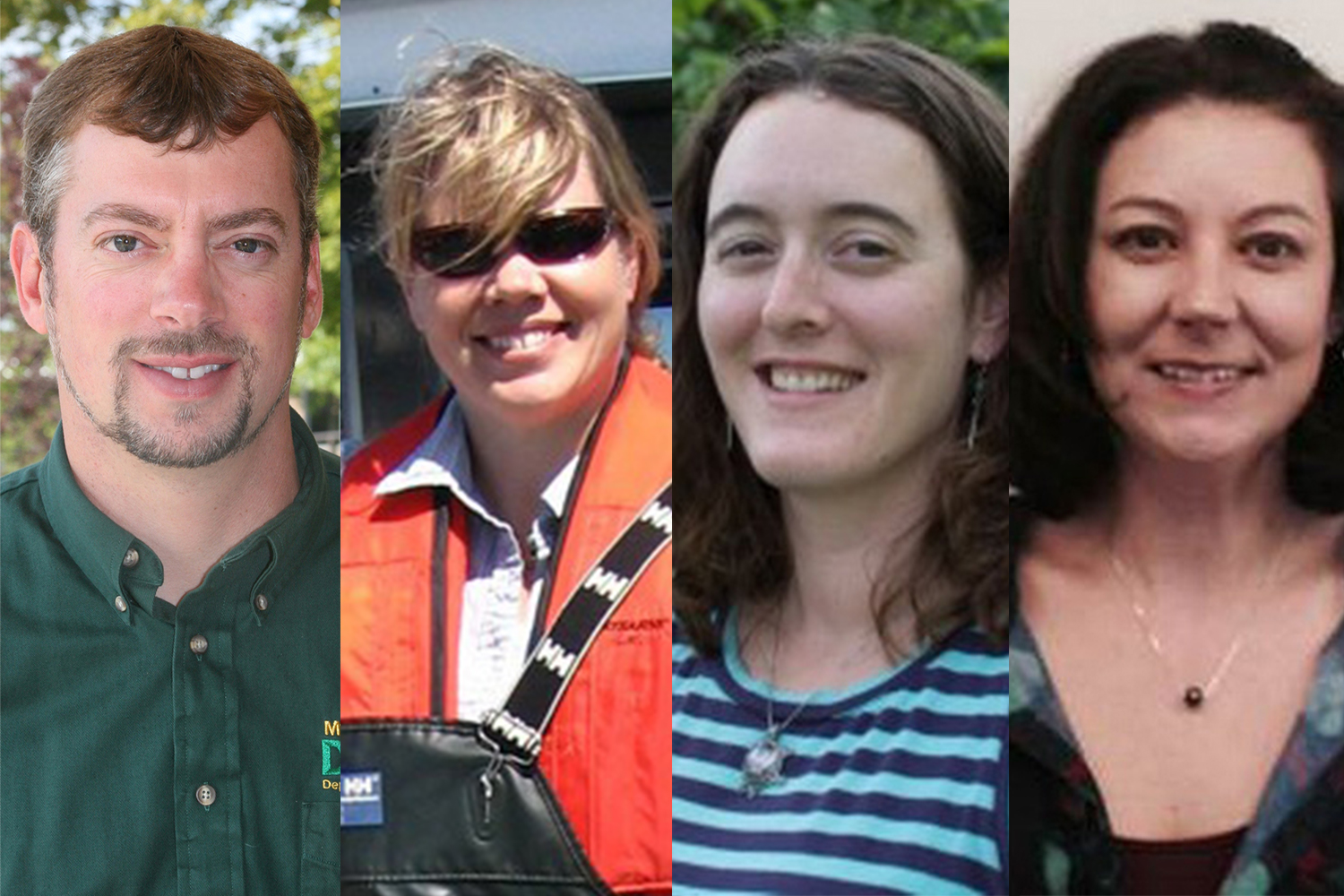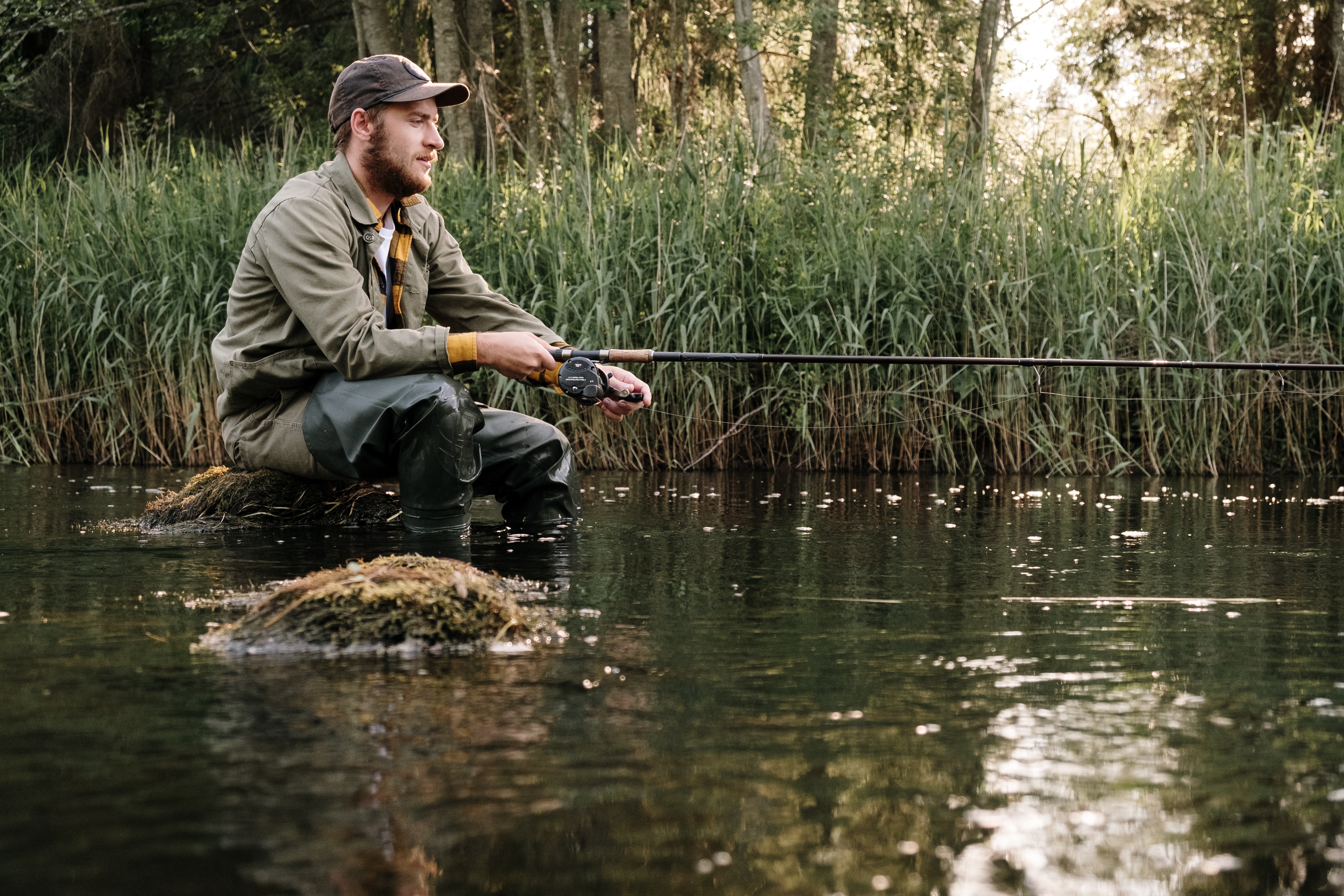Protecting the Au Sable River
As climate change and invasive species continue to threaten Michigan’s fisheries, MSU and the Michigan Department of Natural Resources are working together to assess the resilience of the iconic trout stream.

The sun begins to set on the Au Sable River on a warm summer night in northern Michigan. As the sky turns various shades of red, orange and pink, the sounds of flies buzzing, water burbling and fish gulping for emerging mayflies as they approach the stream’s surface fill the air.
This is when the Au Sable comes alive, says Randy Claramunt, Lake Huron Basin Coordinator for the Michigan Department of Natural Resources (MDNR).

Claramunt, a Michigan State University (MSU) alumnus, is part of a team of MDNR and MSU researchers collaborating on a two-year project that will help keep the iconic Au Sable River vibrant for years to come by assessing its resilience to existing and emerging threats.
The team consists of Claramunt; Tammy Newcomb, senior water policy advisor for MDNR and adjunct professor in the MSU Department of Fisheries and Wildlife; Kelly Robinson, assistant professor in the MSU Department of Fisheries and Wildlife and member of the MSU Quantitative Fisheries Center; and Dana Infante, professor in the MSU Department of Fisheries and Wildlife and MSU AgBioResearch’s assistant director for natural resources management.
“We are developing a strategy that allows us to continue to address and heal the river from the old threats — land use practices, logging and the way people interact with the river — and simultaneously addresses newer threats, such as climate change and invasive species,” Claramunt said.
An iconic trout stream
The 138-mile-long Au Sable River is a coldwater stream that flows through the north central Lower Peninsula — its unofficial epicenter is Grayling — and empties into Lake Huron. It’s an especially popular destination among anglers for its large trout population.
“MDNR has a long history of conducting research, restoration and fisheries management, especially on coldwater streams that were really a driver in conservation for Michigan and North America,” Claramunt said. “Stream trout fishing in Michigan drew anglers like Ernest Hemingway and some of the most influential and original fishing tackle makers, which planted the seed for conservation.”
Climate change could result in more variation in flows and temperatures in Michigan’s trout streams, which could significantly impact the trout that live in the Au Sable River. It can also allow invasive species to have the upper hand in an ecosystem, because some thrive in climates with more variability.
In addition to the environmental damage climate change can cause, potential economic fallout is another possible impact, given that anglers from around the country travel to northern Michigan to fish the Au Sable.
“The Au Sable is one of those rivers that, it's not just the main stem itself, it's also all the tributaries that make up the greatness of this river,” said Newcomb. “Understanding what we need to do to maintain this river, which has such a storied legacy, into the future with climate change and additional development is going to be really important.”
Trout Unlimited (TU), a non-profit conservation organization focused on freshwater streams, was founded on the banks of the Au Sable in 1959. TU, along with local anglers and conservation organizations in northern Michigan, will be involved in the MDNR and MSU-led project.
Applying structured decision-making
To assess the impact of climate change, invasive species, and potential environmental consequences, the team from MDNR and MSU is using a framework called structured decision-making. This iterative process involves defining a problem, objectives that should be achieved to solve the identified problem, actions to take to meet those objectives, potential consequences of the actions and trade-offs among objectives. Scientists, stakeholders, community members and other key groups are directly involved.
“Through the structured decision-making approach, we’ll take an inventory of the data that exist for the Au Sable, both historical data and estimates of future conditions. We’ll engage with the diverse stakeholders who fish that river system, who have a strong interest in what the fishery looks like in the future,” said Infante. “We'll also try to be engaging other stakeholders from throughout the entire watershed, to talk collectively about what can be done to conserve the Au Sable in its current state for as long as we can.”
Robinson is an expert in applying structured decision-making to solve problems in natural resources. She has earned national recognition for her work in applying the process to managing and controlling invasive grass carp in Lake Erie.
“Structured decision-making involves thinking about objectives before you get into potential actions — trying to think first about values, and then how the science can help us to make predictions about how our actions could impact those values,” she said.
Claramunt has previously been involved with past MSU-MDNR collaborations that have used the structured decision-making framework. He's seen that it’s effective from the stakeholder side and scientist side.
“I've really seen it work from multiple sides and I think it's the right approach to engaging stakeholders,” he said. “It’s a framework that also brings people together with the science in a way that allows for a very productive conversation.”
Looking beyond conservation
Structured decision-making allows for a holistic approach to conservation, according to Claramunt.
“You can't look at conservation, especially in a river, in terms of the small stretch that you're familiar with, or this stream or this branch,” he said. “You've got to look at the entire watershed because it's all connected.”

For Claramunt, conservation means that people are part of an ecosystem and help to keep it healthy.
“Good conservation is the best for natural resources management because people then become stewards of the resource, they take ownership in it,” he said. “They actually want to interact with water and fish, but they want to do so in a way that leaves the ecosystem even more healthy, which has benefits for the resources and for us as users.”
“The Au Sable River is a good case in point to why the conservation model works. But I would say we're at a crossroads, to some extent, because there's a lot of debate now about what the right next steps are.”
Using structured decision-making to determine the right next steps is worth the effort, said Robinson.
“It's kind of an arduous process at times, but it's really nice to see when something comes out of it that's useful for managers or stakeholders, whether that's a revised management plan or feeling like it was worth it, like they have a better understanding of what the decision is, how to move forward and what the next steps are,” said Robinson.
Transferable tools to keep fisheries healthy
Eventually, the MSU-MDNR team hopes to apply the structured decision-making to other inland waters in Michigan.
"The Au Sable project will help leadership think about their priorities and where they might invest in helping to sustain their communities,” Newcomb said. “The results from this won't necessarily be transferrable to other rivers, but the tools and the process will be.”
“I see how important our natural resources are to not only the state, but really, the world, here in Michigan with the Great Lakes,” Claramunt said. “The health of fisheries, such as the Au Sable River, really equates to the health of our state.”
Engaging with stakeholders to protect the Au Sable — and in the future, other fisheries in the state — is critical for keeping Michigan healthy.
“This is important for people of tomorrow,” Newcomb said. “We shouldn't be making the decisions that take options out of their hands.”



 Print
Print Email
Email





